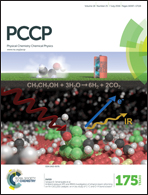A first-principles study of the diffusion coefficients of alloying elements in dilute α-Ti alloys†
Abstract
Using first-principles calculations accompanied by the transition state theory and an 8-frequency model, we present a comprehensive investigation of the diffusion coefficients of substitutional alloying elements X in dilute α-Ti alloys, where X denotes Al, V, Nb, Ta, Mo, Zr, and Sn. The alloying elements Mo and Al exhibit a maximum and a minimum diffusion rate in dilute α-Ti alloys, respectively. It is found that the nearest-neighbor solute–vacancy binding energies and activation energies are roughly inversely proportional to the volume changes induced by solute atoms. There are two exceptions to this trend: Al and Mo. Besides the physical effect (i.e., solute size), two other key factors governing solute diffusion in dilute α-Ti are clarified: the chemical bonding characteristics and vibrational features of X–Ti pairs. It verifies that the ultrafast diffusivity of Mo arises from the interactions with Ti atoms by metallic bonds and its low-frequency contributions to lattice vibration, while the more covalent bonding nature and the high-frequency contributions to the lattice vibration of Al lead to its ultraslow diffusivity. In addition, the correlation effects of diffusion coefficients are non-negligible for the large solutes Ta, Nb, and Zr, in which the direct solute–vacancy migration barriers are much smaller than the solvent–vacancy migration barriers.


 Please wait while we load your content...
Please wait while we load your content...